
Overview

Chrono Trigger is a traditional console role-playing game (RPG) released for the Super Nintendo Entertainment System on August 22, 1995 in North America and for the Super Famicom on March 11, 1995 in Japan. The game is well-known for its multiple endings, Active Time Battle system, and time-spanning storyline. Before its release, Chrono Trigger was a highly anticipated collaboration between Squaresoft and freelance members of Enix. The development team was comprised of the same minds behind the popular RPGs Final Fantasy and Dragon Quest, earning them the moniker of "The Dream Team." The game has sold around 3.5 million copies worldwide across its various ports.
At the time of its release, Chrono Trigger received great praise from critics and fans. Due to the game's multiple endings, story, music (by famed Final Fantasy composers Nobuo Uematsu and Yasunori Mitsuda), battle system, and detailed graphics, the game was so popular it sold two million copies within the first two months of release. Chrono Trigger has since been hailed as one of the greatest games of all time by various popular gaming websites and magazines (placing in the top 100 of IGN, GameSpot, and Famitsu's best games of all time features). Metacritic lists the Nintendo DS version of Chrono Trigger with a 92% or "universal acclaim."
Development
The development of Chrono Trigger was a collaboration between several influential figures in Japanese game development, including Hironobu Sakaguchi (creator of Squaresoft's Final Fantasy series), Yuji Horii (creator of Enix's Dragon Quest series), Nobuo Uematsu (composer of the Final Fantasy series), Yasunori Mitsuda (composer for Chrono Trigger), and Akira Toriyama (creator of the Dragon Ball series and longtime contributor to the Dragon Quest franchise).
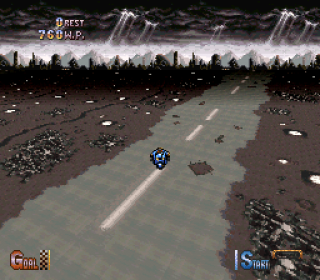
Chrono Trigger was produced by Kazuhiko Aoki and directed by Akihiko Matsui, Yoshinori Kitase and Takashi Tokita. Yuji Horii assisted Hironobu Sakaguchi in the supervision of the game. Yuji Horii, being a large fan of time travel, decided to center the game's plot around time travel. Masato Kato then edited and revised the storyline, and in the process created the idea of multiple endings. Yoshinori Kitase and Takashi Tokita also assisted in the writing of the script. Other designers working on the game include Tetsuya Takahashi, Yasuyuki Honne, Tetsuya Nomura, and Yusuke Naora.
Hironobu Sakaguchi has talked about the development process of Chrono Trigger in a positive light. He cited humorous scenes in the game that he said would not be possible in a Final Fantasy game. He also referred to the development of Chrono Trigger as "playing in Toriyama's universe." Toriyama had a large influence on the game development. For example, when Squaresoft requested a playable animal character in the game, the team based Frog off of one of Toriyama's sketches.
As the game was being developed certain elements were modified from their original designs and ultimately turned into well known parts of the story. When game testers complained about the difficulty and non-linearity of the game, the team added the End of Time so that players could get hints in relation to the next goal. Some of the novel features of the game also proved to be new challenges for the development team, which necessitated extra attention. Sakaguchi required the beta testers to play through the game twice, to confirm that the New Game Plus feature worked.
The Famicom and Super Nintendo versions of Chrono Trigger both utilized 32 megabit cartridges that had RAM and battery backup for saving games. As the Japanese and North American versions of the game were developed on different schedules, they do contain some oddities. For example, the Japanese version contains art for the ending of the game and a running count of the amount of items in the player's inventory, and the North American version still contains an unused song for the unfinished Singing Mountain dungeon.
Localization
Ted Woolsey (an influential figure in translation) was asked to localize the game for North America in only thirty days. He didn't have a modern translation team, so to get the context of the game he had to memorize certain scenarios and read drafts of player's guides to get a feel for the game. Despite these facts, Ted Woolsey still said that this was one of his favorite games to translate.Localization for the North American market changed many things, mostly due to Nintendo of America's stricter standards at the time. References to breastfeeding, alcohol (changed to soda in the North American version), religion, and homosexuality (in the case of Flea, a character who looks physically like a woman but is in reality a man) were either simplified or removed from the game entirely. Localization also changed many of the main characters' names. There are a variety of possible reasons as to why this happened, perhaps because the Japanese names did not sound exotic enough. In the case of a few names, however, there was not enough space for the name to fit using English letters as opposed to Japanese characters.
Connection to Secret of Mana
According to Hiromichi Tanaka in 2011 and 2013, Chrono Trigger was originally planned to be what eventually became Secret of Mana, which itself was originally intended to be Final Fantasy IV and was produced by the team behind Final Fantasy III (Hiromichi Tanaka and Nasir Gebelli). In Tanaka's own words:Gameplay
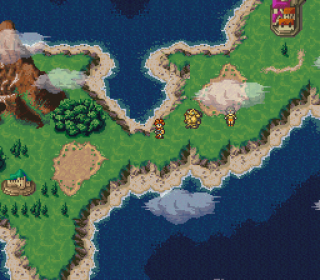
Chrono Trigger takes influence from many elements of traditional Japanese RPG gameplay while abandoning others. For example, it borrows familiar concepts from earlier Final Fantasy games, such as menu and turn based combat, but largely eliminates the RPG staple of random enemy encounters, instead allowing players to view enemies in the field making it possible to avoid many conflicts all together.
Another difference from previous RPGs is that actual battles do not occur on the overworld map. In Chrono Trigger battles occur in smaller exploration areas or dungeons where enemies are displayed in the environment. Aside from making encounters optional, having enemies onscreen also helps create a smoother battle transition since the characters will take battle formation in the onscreen environment instead of the game fading to a separate battle screen. The overworld serves to connect these areas with other places of interest such as town. Towns, as is usual in RPGs, contain areas where the party can rest or purchase items, weapons, and armor.
Chrono Trigger was the first game to coin the term "New Game Plus," though the actual concept had appeared in other games dating back to the original Legend of Zelda. After completing the game, a player can create a New Game Plus allowing him or her to retain all equipment, levels, and Techs (this game's version of special abilities.) New Game Plus also allows the player to fight Lavos, the final boss of the game, much earlier in the storyline, which is how the game's multiple endings can be unlocked.
The time travel aspect of Chrono Trigger transcends story purposes, affecting gameplay as well. Different periods of time become accessible during certain parts of the game. These eras can then be accessed through time portals or (later in the game) through a time traveling device that the party dubs "Epoch." Epoch can travel to any time period instantaneously, while the time portals can only lead the player to certain areas in a time period. Side-quests available in the past time periods of the game can influence events in future areas.
Combat
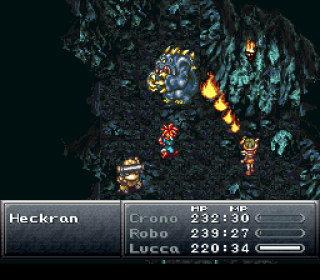
Chrono Trigger utilizes the Active Time Battle system, a battle system popularized by the Final Fantasy series. Each character has a bar which scrolls across based on the character's speed. Once the bar is filled, it is that character's turn.
Unlike many Japanese role-playing games, there is no transition to a separate battle screen when the party encounters enemies. Instead, when a fight begins, a battle menu simply appears on the current area being traversed by the party (which can be moved between the top and the bottom of the screen). Enemies and characters aren't locked to a single grid either, as they move around the area fluidly. Depending on how the enemies and characters are placed on the field, some attacks have more effectiveness than others (for example, attacks that hit enemies grouped together).
In combat, there are three options: Attack, Item, and Tech. Attacking has the character doling out a physical attack. Items are accesible through the second option, providing buffs and healing items. Techs are special abilities that each character can use, both magical and non-magical. Each character has a base magic ability, with abilities such as Water, Lightning, or Shadow (with the exception of Robo, who is a robot and Ayla, who was born before the creation of magic). In addition to individual (or Single) Techs, there are also Double and Triple Techs which involve two and three party members, respectively. Learning a Double or Triple Tech is dependent on which Single Techs the individuals involved have learned. The Double and Triple Techs cost each party member involved a corresponding amount of MP.
Techs
The element of the game which makes it stand out from other RPG's of the time is the tech system. The techs work like standard magic or skills in any other RPG, however Chrono Trigger puts its own spin on things. First off, as opposed to a Final Fantasy where there are dozens of magic options for each character, in Chrono Trigger each character has 10 individual techs which are usually unique to them and their element. These are just solo techs however, a huge element of the battles are the dual and triple techs.To unlock regular techs in the game each battle rewards the player with 3 basic things, money, experience, and tech points. Each character has their own standard of tech points that they need to reach to unlock the next solo tech. Learning dual and triple techs is done completely differently.
Dual and triple techs are techs that need either two or three party members turns to be ready. This is generally a strong move where each character performs a version of one of their own solo techs but they combine it with the other party members involved. These techs generally cost a lot of MP and have the added con of using multiple members turns at the same time for one attack.
Dual and triple techs are unlocked after playing one battle with the duo or trio in question after they have unlocked the single tech that they perform.
When the player begins their journey the first thing they are prompted to do is choose between Active mode and Wait mode. Active mode is the traditional mode which is meant to make the player feel like they are in a rush during battles. During this mode every character has their own ATB bar while the enemies have their own invisible one. When the player is selecting whatever options they want the enemy can attack them at all times.
In Wait mode the players characters can be attacked while they are waiting, however once they enter any combat menu the enemies actions freeze completely. This is an easier mode which gives the player some time to think about their actions.
Plot
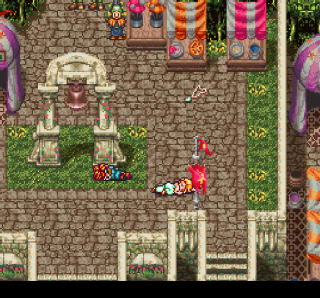
Chrono Trigger takes place in the kingdom of Guardia throughout several different ages, primarily 1000 AD. The game opens with Crono, the game's protagnist, waking up on the day of the Millennial Fair. At the fair, Crono meets Marle, a mysterious and bubbly girl who ends up being teleported to the past after a mishap with a time machine. Crono decides to travel back in time as well and try to save her.
Crono quickly finds that he has been teleported to the year 400 AD. This is an era in which the kingdom of Guardia is at perpetual war with the forces of an evil and powerful sorcerer named Magus.
Upon visiting Guardia Castle, he finds Marle posing as this era's queen, Queen Leene. Unfortunately, their reunion is short-lived, as Marle vanishes suddenly after revealing her identity. On the way out of the castle, Crono finds Lucca, the time machine's inventor and a close friend of Crono, who has also traveled to 400 AD to see how she can help. Lucca tells Crono how Marle is actually the princess in 1000 AD, and that Queen Leene is her ancestor. When the castle guards found Marle, they stopped the search for Leene, essentially guaranteeing her death and ending her line.
Crono and Lucca venture to a cathedral inhabited by monsters disguised as nuns. There, they meet Frog (who is actually Glenn, a knight who Magus turned into an amphibian), and manage to save the real queen as well as the chancellor. This fixes the timeline, and Crono and Lucca return home with Marle using a new device created by Lucca, the "gate key," which stabilizes temporal vortexes and allows the party to traverse time using pre-existing "gates."
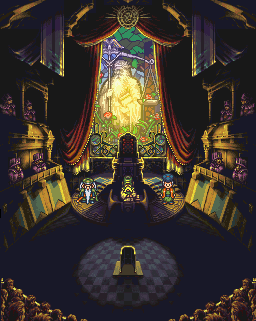
Back in 1000 AD, Crono decides to escort Marle back to the castle. There, Crono is put on trial for allegedly kidnapping the princess and attempting to usurp power from the throne. No matter what the player does at this point in the game, Crono is convicted and thrown into prison.
The player can break out on their own or wait for the execution (in the latter case, Lucca saves Crono at the last moment). The duo battle their way out of the prison, meeting up with Marle, who decides to flee with them. The party finds a portal in Guardia Forest. Cornered, and despite Lucca's protests that they don't know where the gate leads, the group enters the portal.
The party ends up in a post-apocalyptic wasteland in 2300 AD, and quickly discover an information center which gives them the location of another gate. The archive also has visual record of "AD 1999: The Day of Lavos." The video shows a gigantic monster emerging from the ground and destroying the world.
The party decides to change the future by defeating Lavos in their own time.
In another building, the group discovers a broken robot. Lucca decides to repair it, and Marle and Crono name him Robo. He repays the group by escorting them to the gate, located in "Proto Dome," and by helping the group fight off a group of defective robots bent on the destruction of humans.
The gate in Proto Dome takes the party to a hub world known as the End of Time, occupied by Gaspar. Gaspar informs the group that all lost time travelers end up there. The party also meets Spekkio, Master of War, who teaches all the human characters magic.
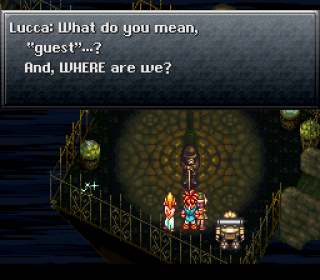
The party learns Magus tried to summon Lavos in 600 AD, but a legendary hero (supposedly Frog) stopped him. The legend says that he wielded a blade called the Masamune that they find broken. The only smith who could fix such a blade would be Melchior, an eccentric old man who lives outside a village of Mystics, the followers of Magus, in the year 1000 AD. After coming to him with the sword, he tells them that he needs a substance known as Dreamstone to repair it, and that such a rare stone only comes from millions of years in the past.
The group travels to 65,000,000 BC, where they meet Ayla, a prehistoric human who saves the group from a group of hostile reptiles known as Reptites. Ayla agrees to give Crono a Dreamstone if he can beat her in a drinking contest. Crono wins the contest, and they all pass out. When they wake up, their gate key is gone, stolen by Ayla's jealous friend Kino. The party navigates through a jungle maze to get the key back, ultimately encountering (and chasing away) Azala, the ruler of the Reptites. During this encounter, the party learns about the advanced intelligence of the Reptites, compared to the still-primitive, barbaric human race.
They travel back to 1000 AD, and visit Melchior, who willingly repairs the Masamune. Crono and company then go back to 600 AD to find Frog, who believes he is unworthy to wield the legendary blade. After some convincing, he agrees, even traveling to the End of Time to learn magic. The party enters Magus' lair, and encounter his three generals: Ozzie (the Trickster General), Flea (the transgendered magician), and Slash (the inhumanly quick swordsman extraordinaire), all of whom the party handily defeats.
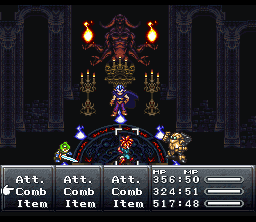
They then face off with Magus, who they believe is in the process of creating Lavos with a powerful spell. Magus recognizes Frog but shows no fear in the face of the Masamune. The party defeats the sorcerer, causing his spell to go awry--Magus then reveals that he was not creating Lavos but merely summoning it so that he could defeat it. The incident causes a massive time gate that sucks the party into 65,000,000 BC.
Here, they meet up with Ayla again, and decide to help her destroy the Reptites, ending the war between them and the humans. After reaching the top of the fortress, it turns out Azala is waiting for an omen that will supposedly bring victory to the Reptite horde. The party is forced to battle Azala and her pet, a massive black tyrannosaurus rex. The group is victorious, and the omen turns out to be Lavos falling to the earth from space. Only Azala recognizes it for what it is: the end of the future.
Crono and friends then travel to a huge kingdom of magic in 12,000 BC. The Kingdom of Zeal is a huge floating continent where humans practice magic, a long-lost technique by the time Frog's era comes around. The people of Zeal are getting all their power through the Mammon Machine, a machine that extracts Lavos' energy for their own good. While exploring Zeal, the party meets a mysterious prophet, who warns Queen Zeal about Crono's plans. A young boy also tells the party, "One among you will shortly perish."
The queen exiles the party to the ground of the world, which is experiencing an Ice Age brought on by Lavos' crash-landing so many years ago. When the group finally gets back to the End of Time, the old man tells them of a machine called the Wings of Time. They journey back to 2300 AD and find the device, a large flying machine which they christen Epoch.
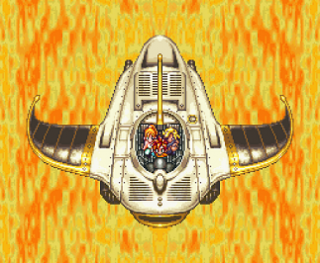
The party travels back to Zeal intent on destroying the Mammon Machine in the Ocean Palace. They arrive too late, however, and Lavos then awakens. The prophet is revealed to be Magus, who attempts to destroy Lavos but is batted aside effortlessly. Lavos stuns everyone, but Crono pulls himself to his feet. He hurls himself at Lavos, but is instantly vaporized. The rest of the party wakes up in a hut on the ground of the world, which is where non-magic users have lived. During the confusion, an advisor to Queen Zeal named Dalton has stolen the Wings of Time (now the "Aero Dalton Imperial"), and has declared himself ruler of the world.
When Frog wakes up, he goes outside and confronts Magus, who cursed him in the first place. Magus, for his part, is cocky, even insulting Crono and calling him weak for trying to stop Lavos. The player is given a choice: let Magus live or kill him and break the curse on Frog. If the player lets him live, he joins the party. The party goes to defeat Dalton, who imprisons them and requires a daring break-out, before being easily defeated. At the end of time, it is revealed that Magus was the mysterious prophet, and he only wanted to summon Lavos to kill it. It is revealed that the old man is a Guru named Gaspar. He informs the party of an egg called the Chrono Trigger, which they can use to resurrect Crono.
At this point in the game, it is up to the player to save Crono or not. The main story is technically over aside from the final confrontation, a series of optional side quests open up, and resurrecting Crono is optional.
If the player decides to revive Crono, Gaspar suggests that they visit Belthasar in 2300 AD. He knows the secret to bringing someone back from the dead. Belthasar tells them that Death Peak (also located in 2300 AD) is the key to reviving their downed comrade. However, there are two requirements: the need for Crono needs to be incredibly great and they will need an exact replica of him (which can be obtained from a magician in 1000 AD). After getting the replica, and visiting the top of Death Peak, Crono can be revived.
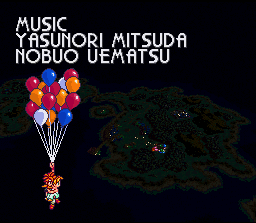
Naturally, only one ending is considered canon. In this ending, the party reaches Lavos and manages to destroy its outer protective shell (either through fighting or crashing Epoch into it). Here, it is revealed that Lavos has been using the planet by harvesting DNA to control its evolution. It then proceeds to take on a final form, which is quickly destroyed by the team.
The game then goes to a celebratory traditional ending at the end of the Millennial Fair. Crono and his friends all say goodbye and return to their respective eras via the time gates. If the player has Magus at this point, he leaves to search for his long-lost sister Schala. Depending on what the player did to penetrate Lavos' outer shell, Crono's mom either jumps into the time gate by accident (prompting the remaining party to go search for her) or Marle assists her father in hanging up Nadia's bell and accidentally getting carried away by some balloons (although she is saved by Crono).
Endings
There are a total of twelve endings in the original release of Chrono Trigger, with an extra variant for the last two endings, adding up to a technical total of fourteen. The PlayStation re-release added an extra two animated endings, bringing the total to sixteen. The DS re-release then added another extra ending, bringing the new total to seventeen endings.
The Dream Team
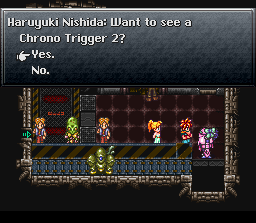
To receive this ending, which is most often regarded as most challenging, Lavos must be defeated when the party makes it to Lucca's teleportation panel. Here, the player meets many of the developers from the game). Additionally, when the credits roll a quote is briefly shown on screen, before the credits quickly scroll at an accelerated pace:
The Wedding
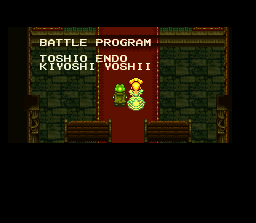
To receive this ending, Lavos must be defeated after rescuing Marle from 600 A.D. The party ends up in the Millennial Fair. After wandering around for a while, the party notices that everyone is reacting strangely to Marle's clothing, saying things such as the fact that she is dressing "normally" again. After reaching the castle, it is revealed that Frog married Queen Leene in A.D. 600.
Nu, Ribbit, and Kilwala
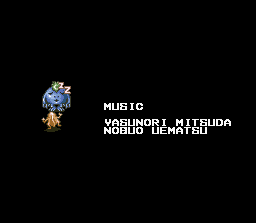
To get this ending, Lavos must be defeated after the first trip to the End of Time, but before the fight on Zenan Bridge. The ending is a Nu, a Ribbit, and a Kilwala engaging in slapstick comedy.
Tata the Hero
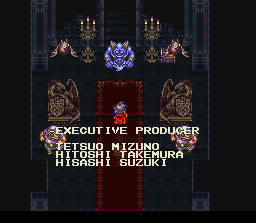
To unlock this ending, Lavos must be defeated anytime after the battle at Zenan Bridge, but before getting the Hero Medal from Tata. The ending shows Tata walking into the chamber in which the party faces Magus for the first time, fires lighting all around him, only to realize that Magus has already been defeated by the party.
Closing Scenes
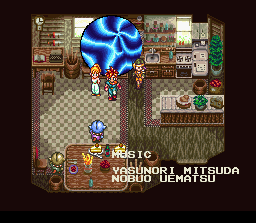
To get the fifth ending, Lavos must be defeated after repairing the Masamune, but before being stuck in 65,000,000 B.C. The ending shows various scenes from the game. Essentially, it is a movie featuring comedic clips from different places in the game.
Still Scenes
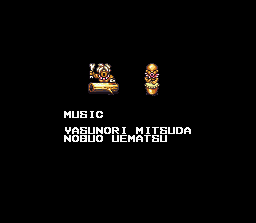
This ending is shown if Lavos is defeated after recovering the Gate Key, but before Frog joins the party permanently. The ending is similar to the "closing scenes" ending, except that it is a slideshow instead of clips. Many of the screenshots depict scenes that aren't actually from the game.
Frog and Magus

To get this ending, Lavos must be defeated after Frog joins the party permanently, but before Magus is defeated in his castle. Frog travels into Magus' Castle to unleash his revenge upon Magus. As Frog unsheathes his sword, the scene cuts to a cloaked figure. This figure could either be Frog or Magus, as they are the only two main characters in the game who wear cloaks.
Reptites
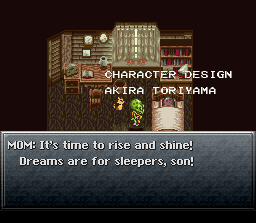
To unlock this ending, Lavos must be defeated after defeating Magus, but before defeating Azala in Tyran Castle. The ending starts off just as the game does, with a bell ringing and Crono's mom waking him up. The major difference, however, is the fact that all of the character sprites are Reptites. Since the party never defeated Azala from his reign of terror, the intelligent Reptite race gains dominance over humans.
Magus' Revenge
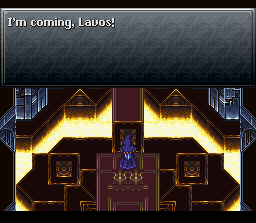
There are two possible ways to receive this ending. The first is to defeat Lavos after defeating Azala in Tyran Castle, but before watching Schala use her magic pendant to open the sealed door in Zeal Palace. The second way is to defeat Lavos after being thrown out of the Zeal Kingdom, but before making it through the Ocean Palace. The ending shows Magus walking alone in scenes that the party has been through in the game, on his own personal quest of revenge: defeat Lavos once and for all.
Girl Chat
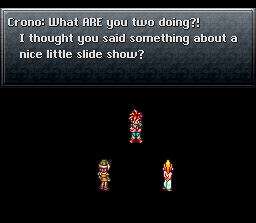
To receive this ending, Lavos must be defeated after seeing Schala use her magic pendant to open the sealed door in Zeal, but before getting Marle's pendant charged. The ending features Marle and Lucca talking about all of the male characters in Chrono Trigger and rating them. This ending is notable for being the only time in the entire game where Crono speaks.
Crono's Death
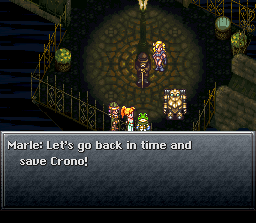
There are two versions of this ending. In order to get this particular ending, the party cannot crash Epoch into Lavos. After Crono's death (and also Magus' death), everybody goes to their respective time period through the time gates. The remaining party members ends up at the Millennial Fair, with Frog being a human again. The remaining members set out to search for Crono. If Magus is still alive, then this ending is essentially the same, except Frog is still a frog.
In another version of this ending, Lavos must be defeated after Crono's death, except the party must crash Epoch into Lavos. This ending is essentially the same as the other version of this ending except for the fact that all of the characters stay behind to go on a search through time for Crono. This ending is slightly different if the player has the Chrono Trigger and if the player saved Lara. If Magus is killed, Frog will still be a frog (unlike in the other version of this ending).
Dream's Epilogue
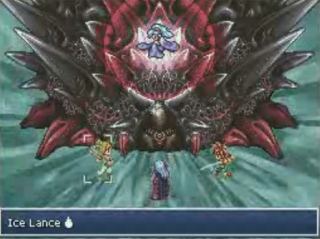
This ending was added in the DS version of Chrono Trigger. To get this ending, Lavos must be defeated after completing the Dimensional Vortex. Then, a new bucket will appear at the End of Time, called the Time's Eclipse. By going here, the party will meet Magus (regardless of whether he is in the party or not). He will offer to fight and flee, but will transform into the Dream's Devourer, who is controlling Schala.
Upon defeating the Dream's Devourer, the party is blown away and Magus and Schala talk. Then, Magus is warped to a forest and apparently loses his memory. He leaves to try and regain it. This is when the PlayStation cut scene plays about the loss of the Masamune. By doing this ending, Crono also gets a new sword, the Dreamseeker, which has a 90% critical hit rate.
Game Over
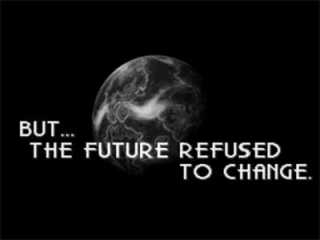
Not technically a good ending to get, but in this ending, the only necessity is to be defeated by Lavos. This ending shows Lavos unleashing his power upon the world and destroying civilization.
PlayStation Ending
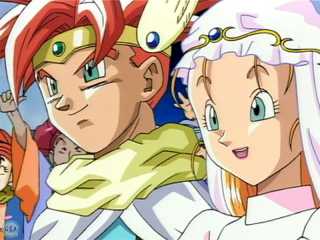
The extra PlayStation ending begins with the marriage of Crono and Marle. All of Guardia Kingdom's citizens are excited and cheering. The scene shifts to 65,000,000 B.C., where Ayla marries her friend, Kino, who is one of Marle's direct ancestors. The scene shifts again, this time to Guardia Castle, where Glenn (Frog's human form) is knighted. He walks through all of the other knights, although his face is never seen.
The scene shifts back to Crono and Marle's wedding, and Melchior stumbles out of the crowd to congratulate them. They come out of the building to be greeted by a huge, cheering crowd. Marle throws her bouquet into the crowd, and the scene shifts again. Lucca is seen walking through a forest with a small green robot similar to Robo. She and the robot discover a baby lying on the ground next to a tree, wearing a strange necklace. She picks the baby up, smiles, and the scene fades to a "fin" screen.
Playable Characters
Throughout the events of Chrono Trigger, a variety of playable characters are introduced and made available to the player. In total, there are five playable characters, with one of the five being an optional character.
Crono
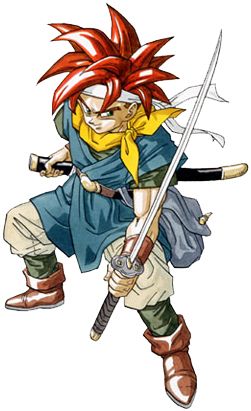
Crono is the main protagonist of the game. He lives with his mother in the town of Truce. After bumping into Marle at the Millennial Fair, he and his friends begin a quest to save the world (after witnessing the "Day of Lavos"). At one point in the game, Crono sacrifices himself in an attempt to destroy Lavos, but it fails and he dies in the process. It is optional, but he can be revived through use of the Chrono Trigger. In one ending cut scene in the PlayStation remake, Crono is seen marrying Marle. He also makes an appearance in the game Chrono Cross, as an apparition.
Crono is a silent protagonist. Most of his emotions and actions are shown through gestures. Crono only speaks once in the entire game, in one of the game's multiple endings.
Crono's attacks are all offensive based, with sparse healing (many of these are cooperative moves) moves as well. After meeting Spekkio, Crono gains the magical ability of lightning.
Marle
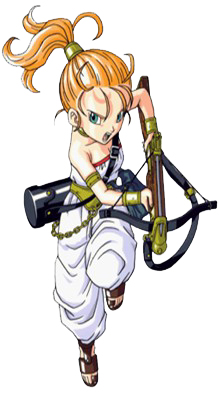
Marle, whose real name is Nadia, is the princess of Guardia, although she does not enjoy being a princess. Marle's weapon of choice is the crossbow. She is a very outgoing type and seems almost tomboyish. She is embarrassed by her ancestry, and at first did not tell Crono or Lucca that she is actually princess Nadia. Marle's element is Ice. Her Techs mainly consist of ice magic, healing magic, and party buffs such as Haste.
Marle meets up with Crono at the fair. After getting Crono to give her a tour around the fair they meet up with Lucca. Marle's pendant causes problems with the teleportation panel, and sends her back in time to 600 AD. She gets mistaken for the missing Queen, her ancestor, and therefore ceases to exist, since the actual queen was never found. When the queen is returned, so is Marle, who decides to stay with Crono after she sees how much he risked just to save her.
Techs
| Tech | Mana Cost | Acquired at | Description |
|---|---|---|---|
| Aura | 1 | 10 TP | Restores a small amount of HP to a single ally. |
| Provoke | 1 | 50 TP | Casts Confuse on a single enemy. |
| Ice | 2 | Spekkio (End of Time) | Attacks a single enemy with an ice elemental attack |
| Cure | 2 | 150 TP | Restores a medium amount of HP to a single ally. |
| Haste | 6 | 250 TP | Speeds up one allies ATB. |
| Ice 2 | 8 | 400 TP | Attack all enemies with an ice elemental attack. |
| Cure 2 | 5 | 600 TP | Restore a large amount of HP to a single ally. |
| Life 2 | 15 | 900 TP | Revive a single ally with maximum HP. |
Lucca
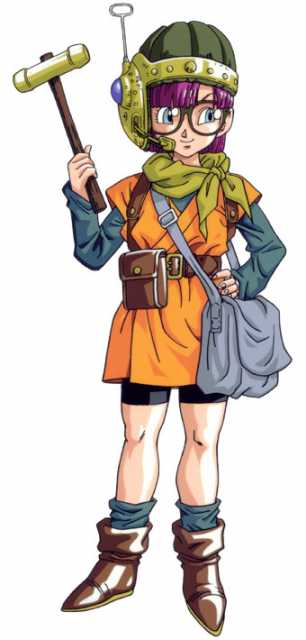
Lucca is Crono's best friend. She is extremely smart, lending to the fact that she spends most of her time building technological devices with her father. Lucca uses different types of projectile based attacks in battle. Lucca will also take out a hammer at times to hit nearby enemies. Lucca's elemental alignment is fire.
After witnessing the Day of Lavos in 2300 AD, she decides to help alter the course of history. She immediately becomes good friends with Robo after repairing him.
In Lucca's endgame sidequest she goes back in time to the moment where her mother Lara was crippled in an accident with one her father Taban's machines. A code must be entered into the machine to stop it from operating. The code turns out to be Lara's name, with the letters translated to the L-A-R-A buttons on a SNES controller. If this is done Lara will appear standing at the fair during the ending.
Lucca appears in Chrono Cross as Dr. Lucca Ashtear. In the game, she has opened an orphanage.
Frog

Frog is a knight from 600 AD. He is the first ally the party meets who is not from their time. His real name is Glenn, but because of a curse cast upon him by Magus he has since taken the form of an anthropomorphic frog. Frog made a promise to himself that day to avenge his fallen comrade Cyrus.
Frog is incredibly close to Queen Leene, vowing to protect her as opposed to the more traditional protection of the king. He is also the wielder of the legendary sword, Masamune. Frog has the special ability of water. Several of his Techs have reptilian references. For example, one Tech summons a large, multicolored frog to come and bounce on the enemies.
Techs
| Tech Name | Mana Cost | Acquired at | Description |
|---|---|---|---|
| Slurp | 1 | 10 TP | Heals a single ally for a small amount. |
| Slurp Cut | 2 | 15 TP | Dashes to a single enemy with his tongue and slashes them. |
| Water | 2 | Spekkio (End of Time) | Attacks a single enemy with a water elemental attack. |
| Heal | 2 | 10 | Restores a medium amount of HP to all allies. |
| Leap Slash | 4 | 250 | Jumps into the sky and dives down with his sword onto one enemy. |
| Water 2 | 8 | 400 | Attack all enemies with a water elemental attack. |
| Cure 2 | 5 | 600 | Restores a large amount of HP to a single ally. |
| Frog Squash | 15 | 1,000 | A desperation attack. Attacks all enemies with a damage formula which gets higher with the more damage Frog has taken. |
Robo
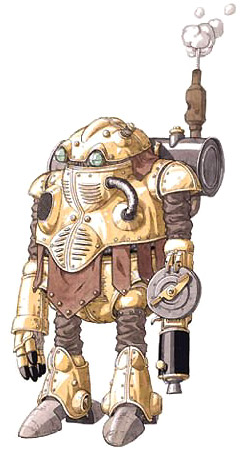
Robo is a robot from the future, whose real name is Prometheus, and whose serial number is R66-Y. Soon after being repaired by Lucca he decides to join the party and help destroy Lavos. He has a strong friendship with Lucca throughout the story. Robo uses his fists to attack the enemies. When Robo meets Spekkio he is told that robots cannot learn magic so he uses normal Techs throughout the game. Many of his Techs, however, can inflict the same status as shadow type magic.
Being a robot, Robo can last for an incredibly long time. Due to this, one of his side quests is focused around restoring a long lost forest, by leaving Robo back in time for 400 years (although the party merely teleports to the present). During this time, he contemplates the existence of an "Entity" that is guiding the party's actions.
Ayla
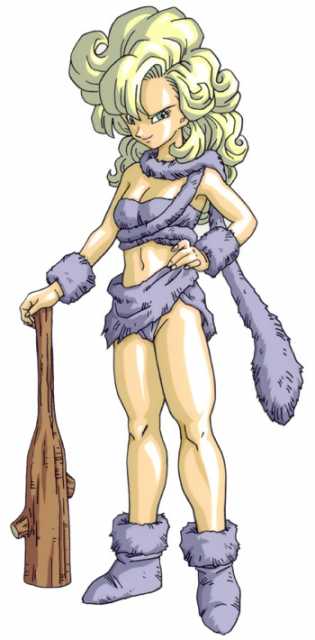
Ayla is a cavewoman from 65,000,000 BC. She speaks in stereotypical caveman speech (leaving out words and referring to herself in third-person). Ayla was, according to Spekkio, born before the invention of magic, making her unable to learn any magic. As reconciliation for this disability, Ayla has incredibly strong physical attacks and Techs. Ayla uses only her body in battle, she uses no weapon despite her art showing her wielding a club.
Ayla agrees to help Crono and his party after they defeat the Reptites, an evolved and intelligent dinosaur-like species that is intent on conquering the world. Lavos first lands in Ayla's time, and causes the complete annihilation of the Reptites, prompting Ayla to resign from her position of chief in her village.
Magus
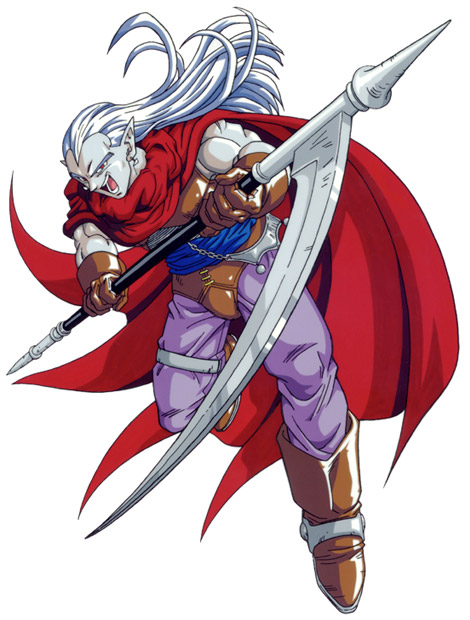
Magus was originally a young boy known as Janus from 12,000 BC, but after an encounter with Lavos, he got sent forward in time to 600 BC, where he encountered Ozzie and founded the Mystics with his magical prowess. Magus then became obsessed with finding his sister Schala and killing Lavos.
At one point in the game, the player has the option to either fight Magus, or have him join the party. Magus specializes in shadow magic, but also possesses several powerful Techs of other elemental alignments.
Additional Characters
Crono's Mom
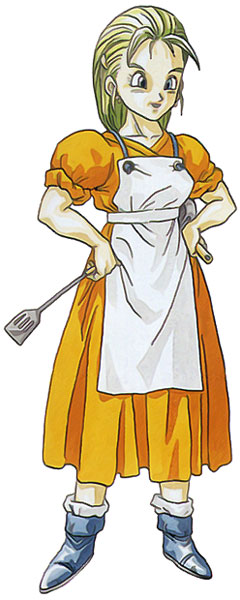
Crono's mom is a simple side character for most of the story. She is best known for her famous line to start the game, "Good Morning, Crono!" which was used in magazine ads for the DS remake of the game. The major interactions the player has with her are in the beginning where she sets the player up to name Lucca and the very end of the game where in one of the two best endings she accidentally runs into a closing teleporter in an attempt to catch Crono's runaway cat.
Although the player only really has two interactions with Crono's mother which are at all relevant to the plot she does have some interesting comments on each of Crono's friends who go along with him on his journey. She can be visited at Crono's house any time during the game after the player can free roam.
Chancellor

The Chancellor is a major side character who appears in the Present and Middle Ages of Chrono Trigger. In both plotlines he is the right-hand man of the King of Guardia but he is known for some suspicious and borderline illegal behavior.
As it turns out, in both time periods, the chancellor has been kidnapped by the monster Yakra and hidden in a treasure chest. So while he is a villain for the early portions of the game, it turns out that he is actually a good guy and on the Princess' side at all times.
Spekkio
Spekkio in all six of his forms.Spekkio is the character from the End of Time and probably the most important side character in the game besides Crono's mom. When the group first meets Spekkio in the end of time he will likely be in his second form, the Kilwala form. He will give each party member their respective elemental magic. As the player gets more party characters they should revisit Spekkio to gain the first level of elemental magic for each character.
The characters elemental alignments are:
Crono - Lightning
Lucca - Fire
Marle - Ice
Frog - Water
Robo - Non elemental but some Shadow related attacks
Ayla - Non elemental, purely physical attacks.

Magus - Shadow alignment, however holds the Fire 2, Ice 2, and Lightning 2 spells as well.
Other Versions and Sequels
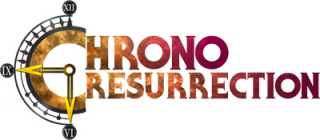
Chrono Trigger, as the first game in the Chrono franchise, has had numerous ports. Chrono Trigger has been included on Final Fantasy Chronicles for the PlayStation, released as a standalone PlayStation remake, re-released on the Nintendo DS, on Virtual Console, ported to both iOS and Android, and released on PC (via Steam).
At the time of its release, Chrono Trigger had three companion Satellaview games released: BS Chrono Trigger: Character Library, BS Chrono Trigger: Music Library, and BS Chrono Trigger: Jet Bike Special. The first two are just that; a character library and a music library. The third, however, is the jet bike racing minigame from the actual game, in which the player races against Johnny on a Mode 7 post-apocalyptic racetrack.
Chrono Trigger on the PlayStation is not quite as rare as the Super Nintendo version. The PlayStation release was developed by TOSE Co. Ltd., and released on November 2, 1999 in Japan (as a standalone re-release) and on June 29, 2001 in North America as Final Fantasy Chronicles (the compilation merely contained an English version of the Japanese re-release). It added animated cutscenes, as well as an additional ending. The PlayStation version is also known for having longer load times and the ability to have more than the three files of the Super Nintendo version.
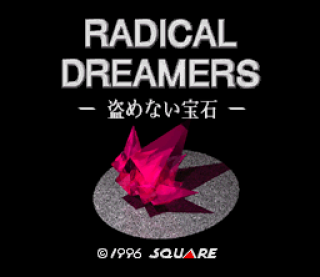
The Chrono Trigger fan community has also developed several notable projects. Chrono Resurrection is an unreleased fan remake of several scenes from the game. Many high-profile game critics complimented the ambition of the project, and noted the professionalism of the project. However, Resurrection was halted when a cease and desist letter arrived from Square Enix, requesting that production be stopped.
Another similar project that was halted in mid-development was more ambitious; it sought to remake the entire game. This project was known as Chrono Trigger Remake Project until it was shut down due to a cease and desist letter from Square Enix.
Several other fan projects were shut down by Square Enix, many of which originated on Chrono fan-site Chrono Compendium. On May 8, 2009, Square Enix sent a cease and desist to the website for their Chrono Trigger: Crimson Echoes project, as well as requesting that the website remove information on other fan projects and ROM hacks: Chrono Trigger: Prophet's Guile, Chrono Trigger Retranslation, Chrono Trigger Re-amped, Chrono Trigger Rebirth, and Chrono Trigger Azala Style.
Chrono Trigger has since had two sequels: Radical Dreamers: Nusumenai Hoseki and Chrono Cross. Radical Dreamers was only released in Japan, but Chrono Cross was released worldwide for the PlayStation. Square Enix applied for the trademark Chrono Break in 2001, which has caused many fans to speculate about the possibility of the series continuing.
Prerelease Versions
There are two known prerelease versions (an alpha and a beta). The beta version has been leaked onto the internet and even translated into English. The alpha version was shown in preview videos and screenshots. Differences include an extra door in 600 AD Guardia Castle, paler guard sprites, no spikes in Crono's hair, five levels of elemental power (opposed to just one), large overworld differences, rough musical tracks, a slightly altered Epoch sprite, altered dialogue, changed door seal design, and a slightly different Arris Dome.
The beta version, having been released onto the internet in ROM format, has much more information surrounding it. Known as the prerelease version (rather than beta), it is dated November 17, 1994, and was sent to reviewers and retailers to give a sample of what Chrono Trigger was before it was released. The prerelease is not a complete game. There are barriers blocking the way in Guardia Castle, Lab 32, and Magic Cave. By using location offsets, however, the player can access much more of the game. Location offsets are two digit hexadecimal codes that can be used with the code 7E0100XX (XX being the location offset). There are two other ways to access other areas in the game. The first is to use saved games in an emulator. The last way is to use the Epoch, which despite having a different sprite is completely functional in the prerelease. There are areas where the player can't access, but these are all places that aren't usually accessible via the Epoch. The Epoch sprite is likely one of the most different sprite in the prerelease (as other sprites have minor changes and palette swaps as opposed to large differences).
The guard overworld sprite is located at the bottom; it is believed to have been a barrier.
It has been long-rumored that Schala was a playable character in a prerelease version of Chrono Trigger. By examining the data in the ROM, it has been determined that this rumor is false. Not only are there no extra sprites for Schala (most importantly, no overworld sprites), there is not an eighth character slot and Schala's graphics are compressed (like all other non-playable characters, and unlike the decompressed graphics of the playable characters). If a playable character did have compressed graphics, it would give the game huge slowdown because the CPU would have to decompress the graphics during gameplay.
Additionally, there is a guard overworld sprite in the overworld sprite data. At first, it was rumored to be an eighth character, but after analyzing non-playable character data, it has been found that the overworld sprite was likely a barrier to prevent the player from progressing, but was removed as the developers found a way to use the environment as a barrier instead. There are many other minor differences, mostly related to minor graphical, dialogue, and sound changes.
DS Version
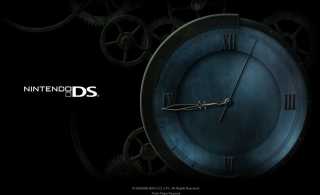
The Nintendo DS version of Chrono Trigger was released on November 25, 2008 in North America, November 20, 2008 in Japan, and February 6, 2009 in Europe. This version adds many new features, but retains the gameplay and graphical style. The game features an all-new translation, the anime cut scenes of the PlayStation remake, and several new gameplay modes.
The game can be played in either one of two modes: DS Mode and Classic Mode. DS Mode features touch-screen controls, while Classic Mode is the original game. New dungeons have been added as well, including Dimensional Vortex and Lost Sanctum. The Lost Sanctum is an area where the player can go for various side quests that can be done for items and money. These dungeons also contain new bosses, and in the case of Dimensional Vortex, a new final boss and a new ending. The graphics have been slightly altered, adding new sprites and animations in some cases.
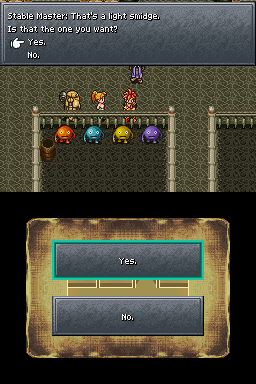
The Arena is a completely new mode in this version of the game. In this area, the player can raise creatures and align them to one of the four elemental types. Then, the player is granted with the choice of one of four "Smidges," each aligned with a corresponding element. Then, the player can send the creature into an area that has already been visited for training. Items for these creatures can be bought from a Nu merchant in the arena. Additionally, other non-playable characters' creatures can be fought using a trained Smidge.
An Extras section has been added with various items, and a few hidden ones. This section is unlocked upon saving the game. There are two extra sections that can be unlocked as well, one being a Treasure Atlas and the other being the Endings, but both have certain requirements regarding position in the game.
- Theater - The theater has all of the cut scenes that the player has seen. Here, they can be viewed again.
- Art Gallery - The art gallery contains concept art for most of the characters from the game (as well as objects and creatures).
- Music Box - The music box is essentially the soundtrack for the game, containing all of the songs encountered in the game (and even the two unused tracks).
- Dojo - The dojo lists all of the attacks from the game (be it a single, double, or triple tech). The tech must be unlocked in the game for it to show up in the dojo.
- Bestiary - The bestiary lists all of the enemies encountered during the game. Information about each enemy can be viewed, from stats to techs.
- Item Encyclopedia - The item encyclopedia is almost exactly the same as the bestiary, except it lists all of the items that have been obtained rather than enemies seen.
Other Media
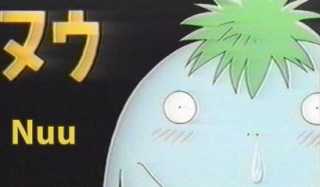
For several years, rumors circulated about the possibility of a Chrono Trigger anime. The rumors were partially true. An anime based on Chrono Trigger did exist, but it was a one episode special. The special was made in 1996 for a V-Jump convention. Titled Time and Space Adventures - Nuumamonjaa, the episode was sixteen minutes long. It followed a Nu and a Poyozo doll as they attempted to sell wares at a monster version of the Millennial Fair.
A short manga was in the Japanese Chrono Trigger player's guide. Only ten pages long, it was a brief and comedic story following Crono. In the manga, he meets Marle and samples Lucca's teleportation device. The story ended quickly, although it was merely meant to be an introduction to the game. Another short manga was created that was essentially a manga version of the Chrono Trigger original animation video. It ran for several issues in the V-Jump magazine around and after Chrono Trigger's release. In addition, the magazine featured other specials relating to Chrono Trigger, most notably a large 3D model of Robo.

Chrono Trigger, considering its popularity, had many guides released covering the game. Naturally, there was the Official Player's Guide from Nintendo Power (that was also used as a subscription bonus to Nintendo Power). Two other guides were published in Japan. Chrono Trigger: The Perfect is notable due to the fact that it contained much more information beyond that of a regular guide.
This guide contained interviews from Yuji Horii and Hironobu Sakaguchi, two well-known developers who worked on the game. The second Japanese guide was Chrono Trigger Super Famicom Player's Guide, which contained the short manga based on Chrono Trigger (detailed above). Other than that, it was a traditional guide.
Much more official merchandise was created for promotion of Chrono Trigger. Prior to the release of Chrono Trigger, many "prism cards" were released that showed scenes and characters from the game. These cards are especially notable for their depictions of scenes that differ from the actual game (showing insight on the game's development and prerelease versions).
In addition, many of the cards had "mockups," which are scenes that the developers created for promotional purposes, and do not actually appear in the game. The cards were holographic, making them difficult to spread on the internet (as noted by Chrono Compendium, which has images of all of the cards). Other merchandise for Chrono Trigger includes bookmarks (released to promote the PlayStation rerelease) and keychains (also released of Chrono Cross, possibly sold at arcades prior to the games' releases).
Fan Remakes, Rom Hacks, and Rereleases
Chrono Trigger had two popular rereleases which each added their own content. The first of the two was on Playstation in 2001. The game was rereleased on a disc collection entitled Final Fantasy Chronicles which contained a rerelease of Chrono Trigger with an added animated ending and a series of animated cutscenes throughout the game, and a rerelease of Final Fantasy IV with 3D cutscenes.
In 2009 Chrono Trigger was rereleased again on the Nintendo DS. This version included the anime cutscenes added in the 2001 rerelease as well as having a whole new battle mode and introducing a new extra dungeon. In addition to this, the game also changed its visual format to use the most potential of the Nintendo DS' dual screens. In battle the menu options are on the bottom screen while the top screen shows the entirety of the battlefield along with the characters involved in the battle.
The Playstation rerelease version has become the defacto version in any new rereleases of the game.
The fanbase of Chrono Trigger also spawned multiple ROM hacks in an attempt to followup the story. The two most popular of which are Crimson Echoes and Flames of Eternity.
Crimson Echoes acts as its own standalone plot, with a story mode that can take almost as long as the original game to complete. The game features all of the same characters returning together again to defeat a whole new evil with time travel. One of the additional positives about this game is that it takes the player to times that are different than the time periods they visit in the original game.
Since the games official release in 2009 there has been a large market online of people writing the ROM to blank carts, putting labels on them and selling them as individual SNES cartridges.
Soundtrack

Yasunori Mitsuda
Chrono Trigger's music was composed by Yasunori Mitsuda and Nobuo Uematsu. Chrono Trigger was the first game that Yasunori Mitsuda composed for (later becoming well-known for his work not only in Chrono Trigger, but other popular role playing games such as Xenogears and Chrono Cross), but by then Nobuo Uematsu was a longtime Final Fantasy composer. One track in Chrono Trigger was also composed by Noriko Matsueda.
Mitsuda was asked to work on Chrono Trigger when he became unhappy with the pay of being a sound programmer. Mitsuda took the job and set out on a goal to create music unlike any before. Many of his tracks were inspired by dreams, such as To Far Away Times. Later, Mitsuda had to leave development because of a hard drive crash (losing several in-progress songs) and stomach ulcers. At that time, Nobuo Uematsu came in to compose the remaining tracks.
Chrono Trigger's music has been released in many soundtracks. The Original Sound Version was released in North America on January 21, 1995. The Original Sound Version contained three discs of 64 different songs, totaling at two hours, thirty-nine minutes, and fifty-two seconds. An arranged version of the soundtrack called Chrono Trigger Arranged Version: The Brink of Time was released on June 25, 1995. Unlike the Original Sound Version, it only contained one disc of ten songs totaling at fifty-two minutes and fourty-seven seconds.
Two other soundtracks (Chrono Trigger Orchestra Extra Soundtrack, and orchestral arrangement soundtrack, and Chrono Trigger Original Soundtrack, a compilation of the "greatest hits" from the game) were also released. In addition, fans from OverClocked Remix, a site well-known for their work on Super Street Fighter II Turbo HD Remix, released an album known as Chrono Symphonic
Original Sound Version
The Original Sound Version release of the Chrono Trigger soundtrack was released on March 25, 1995. With a total duration of 2:39:52, the soundtrack includes a total of 64 tracks across three discs.Disc One

- A Premonition - 0:34
- Chrono Trigger - 2:01
- Morning Sunlight - 0:58
- Peaceful Days - 2:48
- Memories of Green - 3:51
- Guardia Millennial Fair - 3:10
- Gato's Song - 0:42
- A Strange Happening - 1:43
- Wind Scene - 3:22
- Good Night - 0:08
- Secret of the Forest - 4:46
- Battle 1 - 2:29
- Guardia Castle - Courage and Pride - 3:28
- Huh!? - 0:05
- Manoria Cathedral - 1:13
- A Prayer to the Road That Leads - 0:11
- Silent Light - 2:23 (Nobuo Uematsu)
- Boss Battle 1 - 1:58 (Noriko Matsueda, Nobuo Uematsu)
- Frog's Theme - 1:49
- Fanfare 1 - 1:16
- Kingdom Trial - 3:44
- The Hidden Truth - 0:59
- A Shot of Crisis - 2:39
Disc Two
- Ruined World - 3:24
- Mystery from the Past - 0:07 (Uematsu)
- Lab 16's Ruin - 1:34
- People Without Hope - 3:07 (Uematsu)
- Lavos' Theme - 5:10
- The Last Day of the World - 1:25
- Robo Gang Johnny - 2:21
- Bike Chase - 1:35 (Uematsu)
- Robo's Theme - 1:32
- Remains of the Factory - 3:09
- Battle 2 (unreleased track) - 2:10
- Fanfare 2 - 0:07
- The Brink of Time - 2:31
- Delightful Spekkio - 2:48
- Fanfare 3 - 0:05
- Underground Sewer - 2:24 (Uematsu)
- Boss Battle 2 - 2:41
- Primitive Mountain - 3:07 (Uematsu)
- Ayla's Theme - 1:24
- Rhythm of Wind, Sky, and Earth - 1:51
- Burn! Bobonga! - 2:12 (Uematsu)
- Magus' Castle - 0:29
- Confusing Melody - 1:40
- Battle with Magus - 3:30
Disc Three
- Singing Mountain (unreleased track) - 3:05
- Tyran Castle - 3:49 (Uematsu)
- Depths of the Night - 2:31
- Corridor of Time - 3:01
- Zeal Palace - 3:57
- Schala's Theme - 2:48
- Sealed Door - 2:47 (Uematsu)
- Ocean Palace - 3:23
- Crono & Marle - A Distant Promise - 1:56
- The Epoch - Wings of Time - 3:23
- Black Omen - 3:04
- Determination - 0:56
- World Revolution - 3:48
- The Final Battle - 4:07
- Festival of Stars - 2:44
- Epilogue - To My Dear Friends - 2:34
- Outskirts of Time - 5:46
Chrono Trigger Arranged Version: The Brink Of Time
The Arranged Version of the Chrono Trigger soundtrack includes a variety of acid jazz remixes of the original songs, composed by Yasunori Mitsuda. Released on June 25, 1995, the soundtrack has a total runtime of 52:47.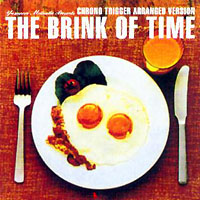
- Chrono Trigger - 6:13
- Secret of Forest - 6:10
- Zeal Palace - 4:46
- Warlock Battle - 3:46
- Chrono Corridor - 7:15
- Undersea Palace - 4:09
- World Revolution - 6:03
- The Brink of Time - 2:45
- Guardia Millennial Fair - 6:28
- Outskirts of Time - 5:08
Chrono Trigger Original Soundtrack
The Chrono Trigger Original Soundtrack, released on December 18, 1999, is essentially a "greatest hits" album meant to coincide with the release of the PlayStation version of Chrono Trigger. Including a total of 30 tracks, this soundtrack has songs from the original game, the PlayStation rerelease, and the Brink of Time album. The Original Soundtrack's runtime is 1:14:12.- A Premonition - 0:36
- Chrono Trigger - 2:33
- Peaceful Days - 2:45
- Guardia Millennial Fair - 3:18
- Wind Scene - 3:21
- Mystery of the Forest - 4:47
- Frog's Theme - 1:17
- The Kingdom Trial - 3:45
- Lavos' Theme - 5:10
- Reckless Robo Gang Johnny - 1:43
- Robo's Theme - 1:31
- The Brink of Time - 2:32
- Delightful Spekkio - 2:47
- Decisive Battle with Magus - 2:44
- Corridors of Time - 3:02
- Zeal Palace - 3:58
- Sara's Theme - 2:44
- Undersea Palace - 3:20
- World Revolution - 3:52
- Epilogue ~To Good Friends~ - 2:26
- To Far Away Times - 4:15
- Crono and Marle (Arrange Version 1) - 0:38
- Chrono Trigger (Arrange Version 1) - 2:03
- Ayla's Theme (Arrange Version) - 1:31
- Frog's Theme (Arrange Version) - 2:00
- Chrono Trigger (Arrange Version 2) - 0:35
- Chrono Trigger (Arrange Version 3) - 0:27
- Sara Theme (Arrange Version) - 1:40
- Ending ~ Burn! Bobonga! ~ Frog's Theme ~ To Far Away Times (Arrange Version) - 1:04
- Crono and Marle (Arrange Version 2) - 0:39